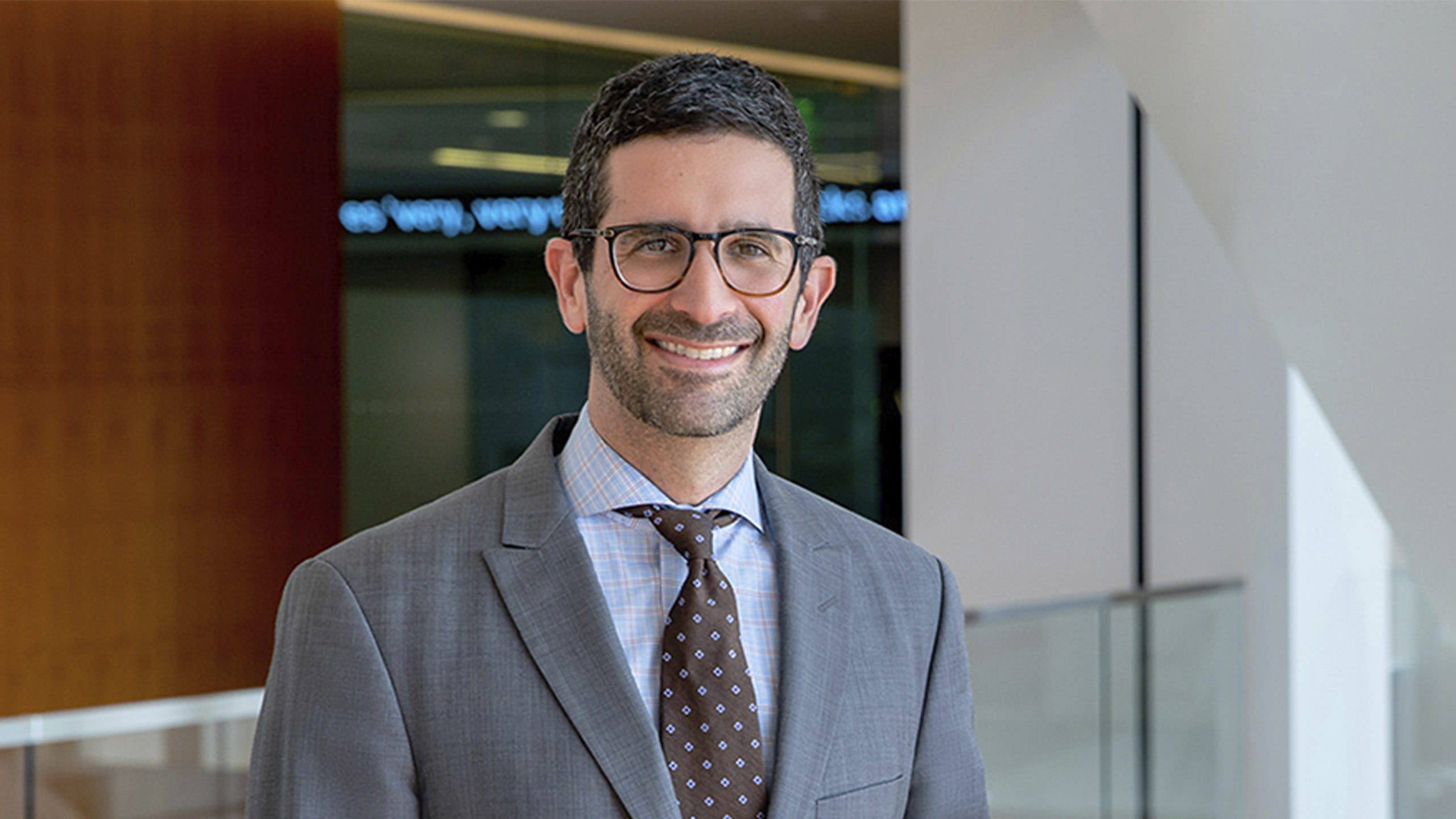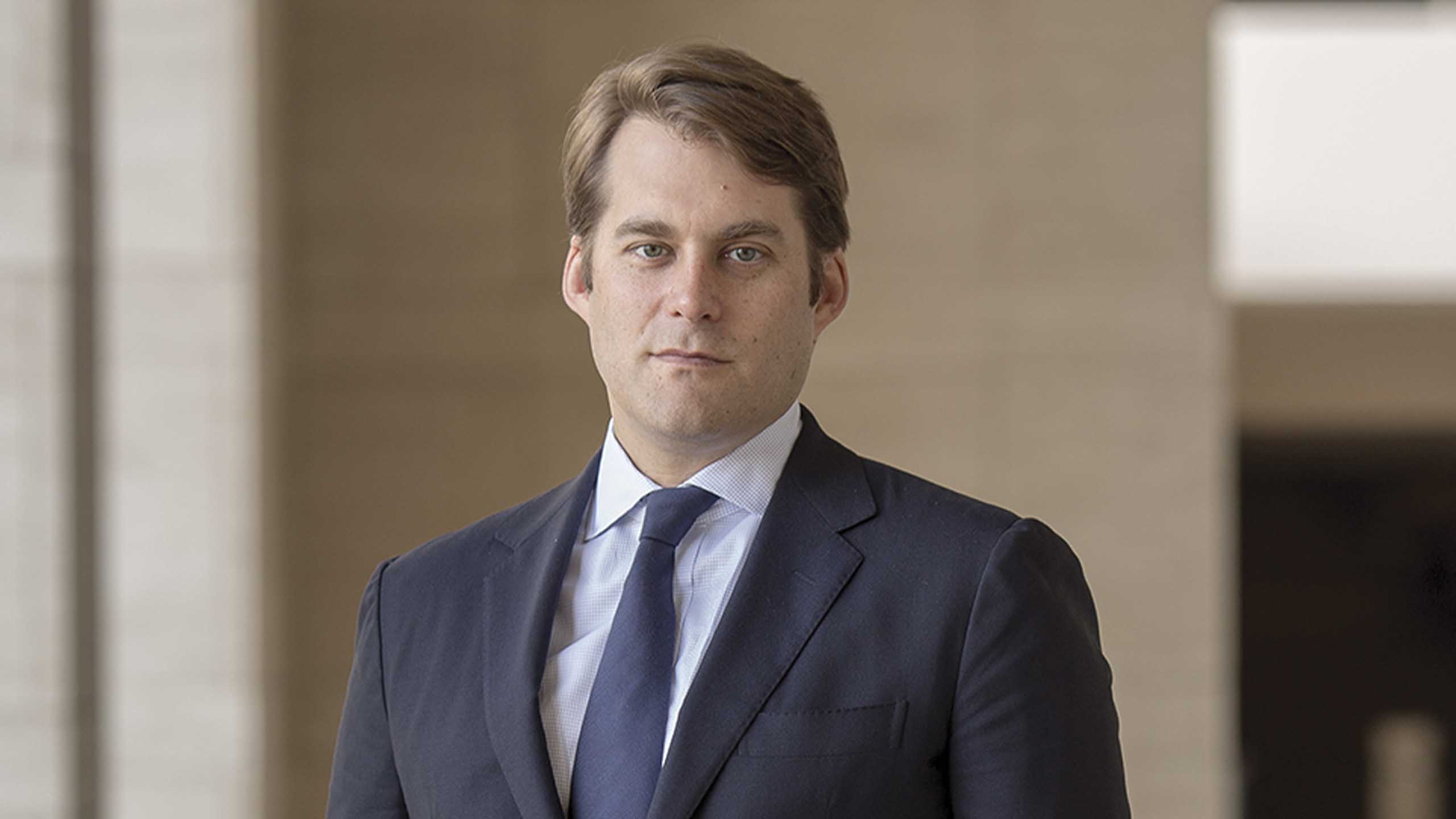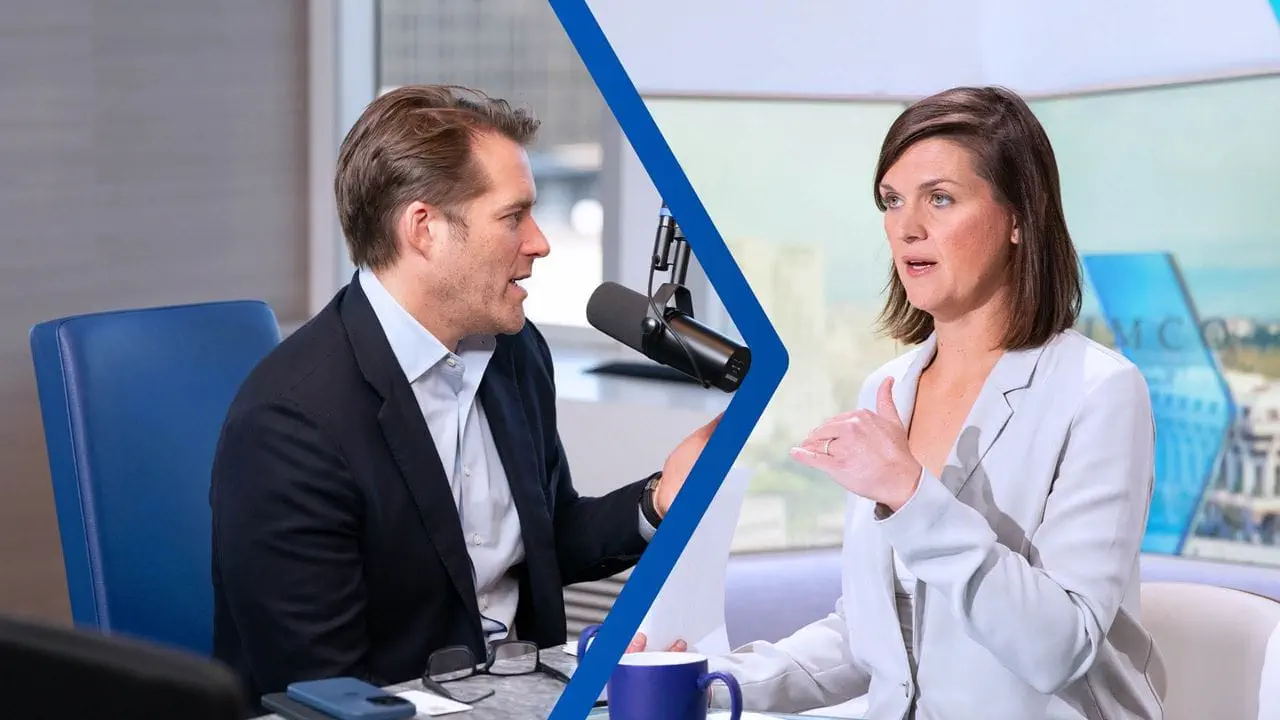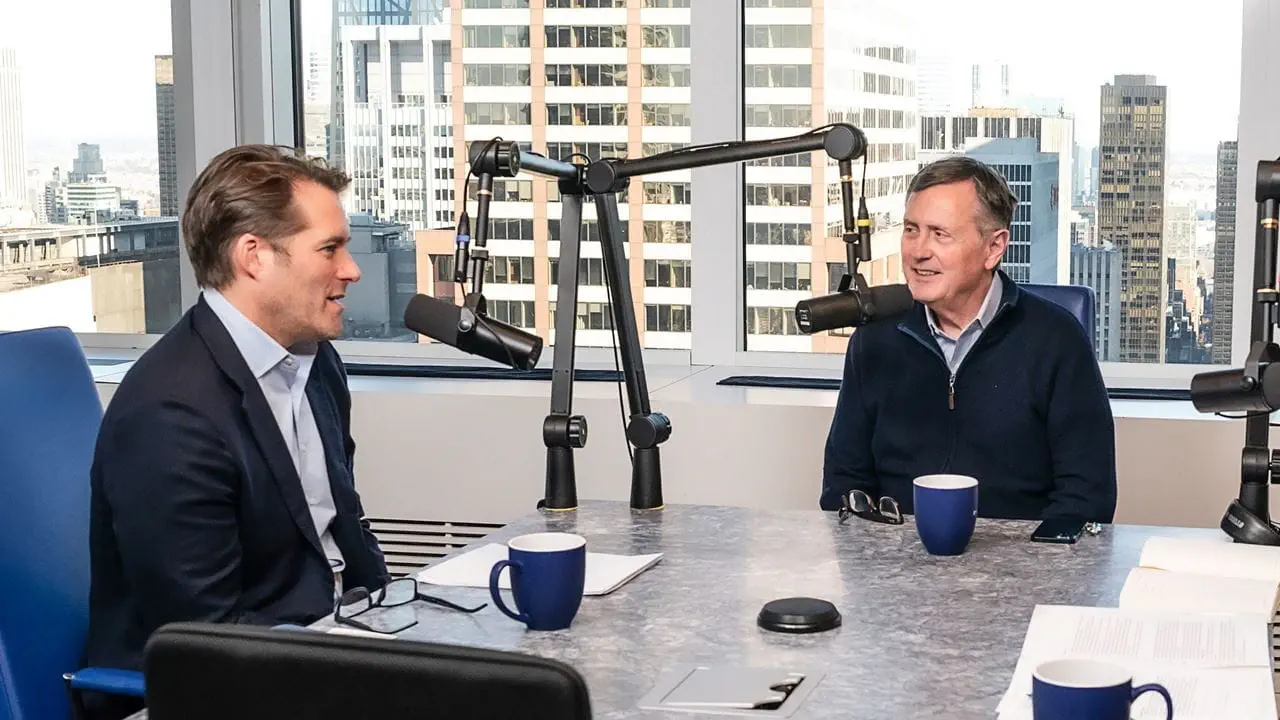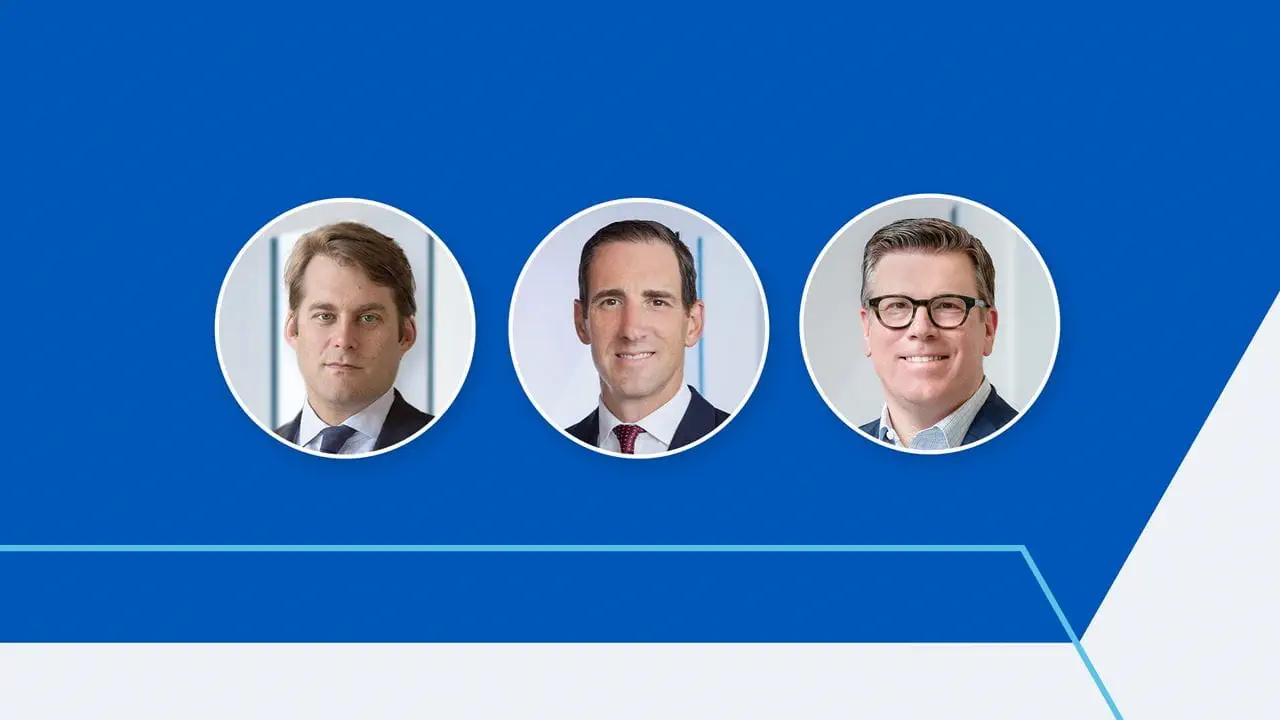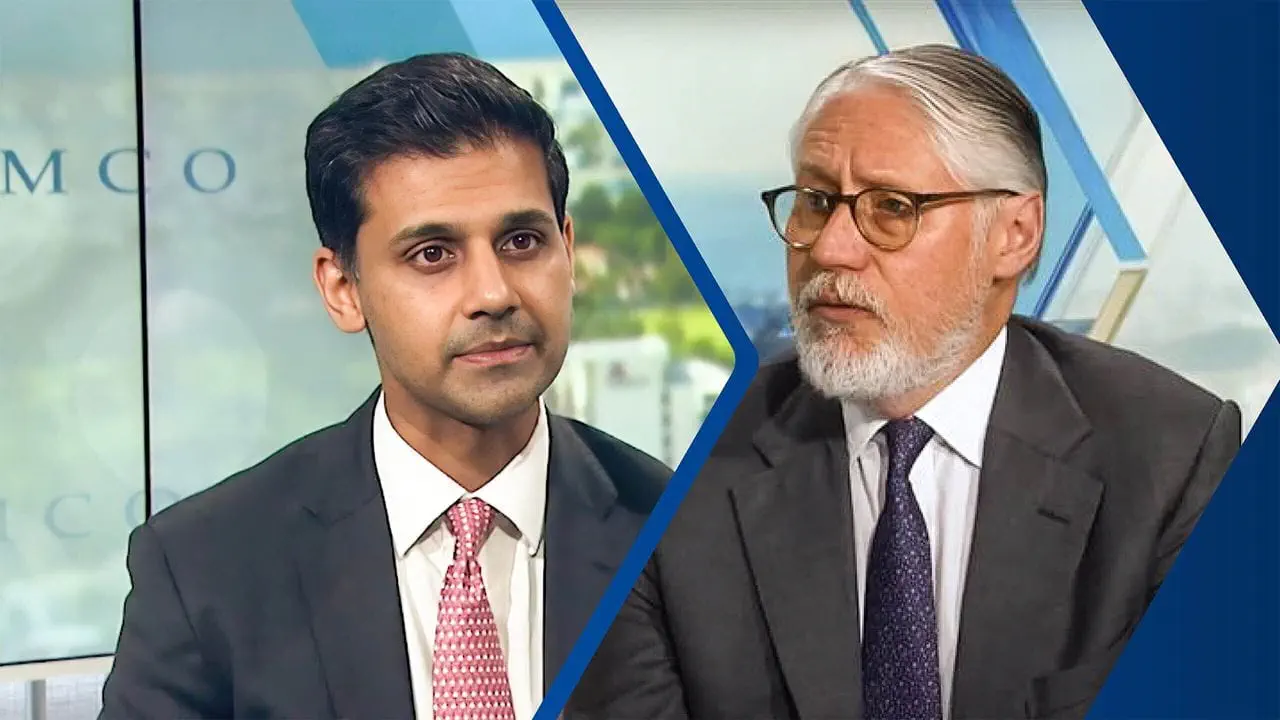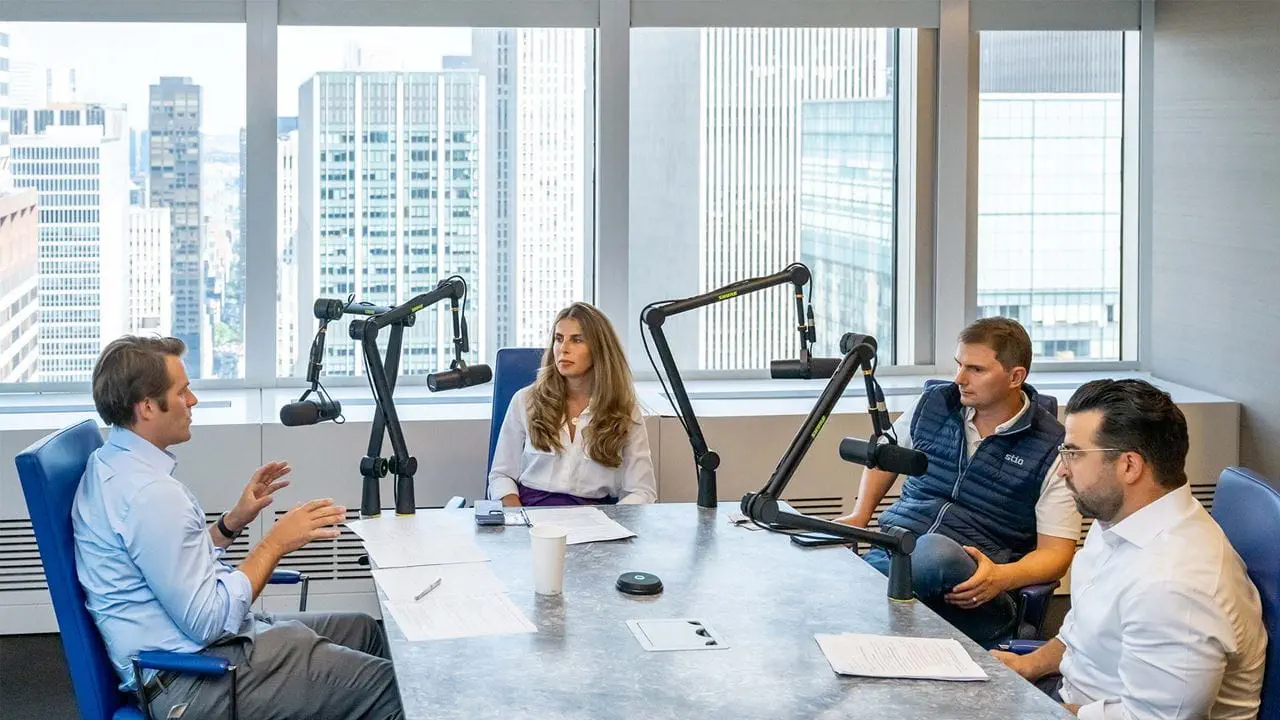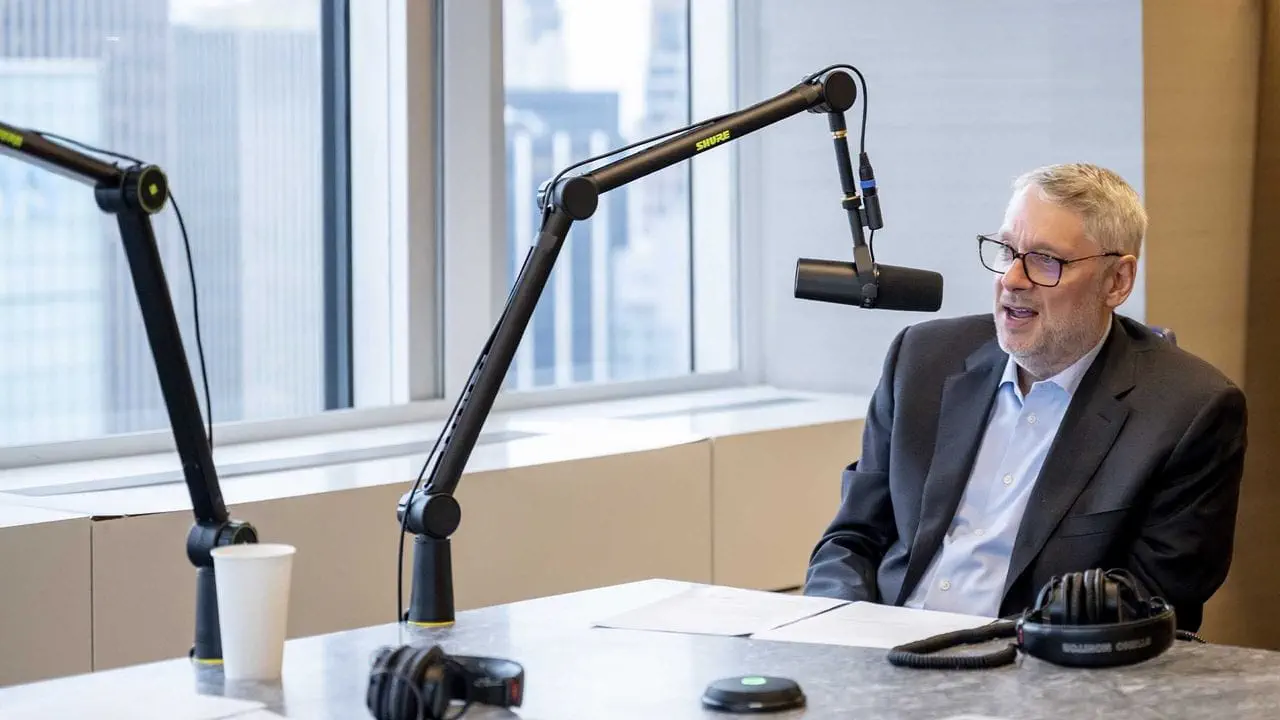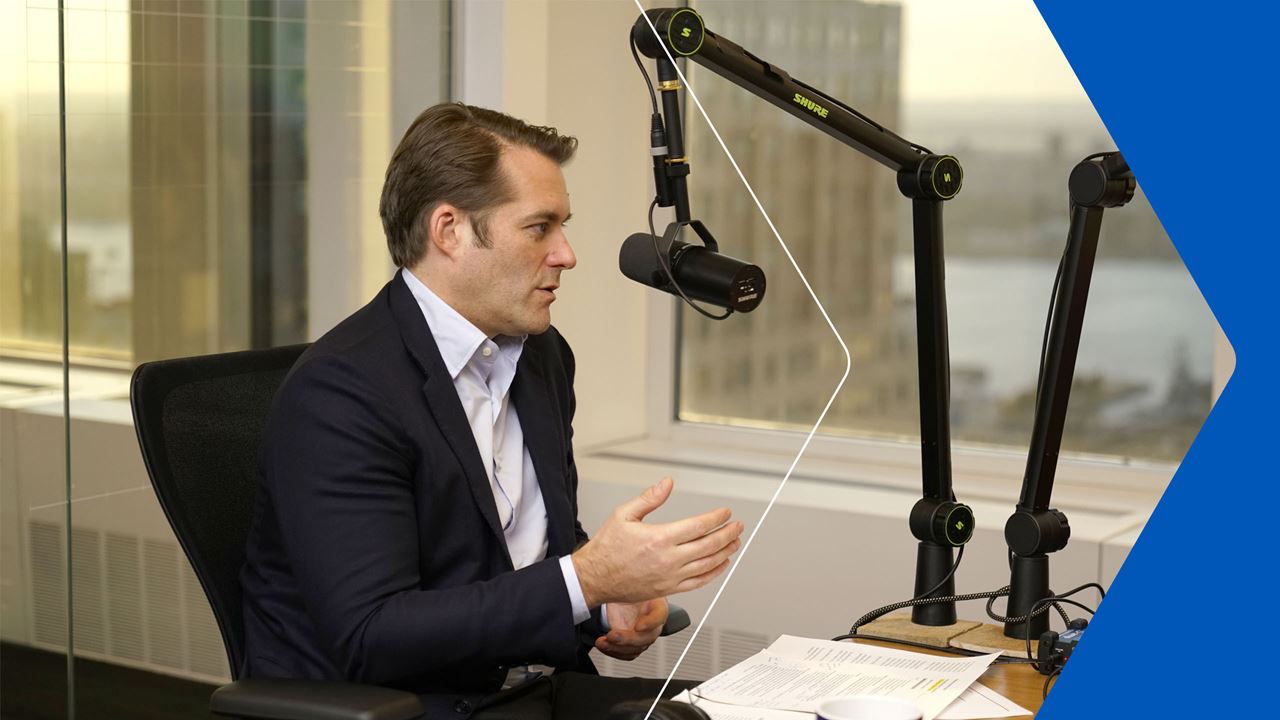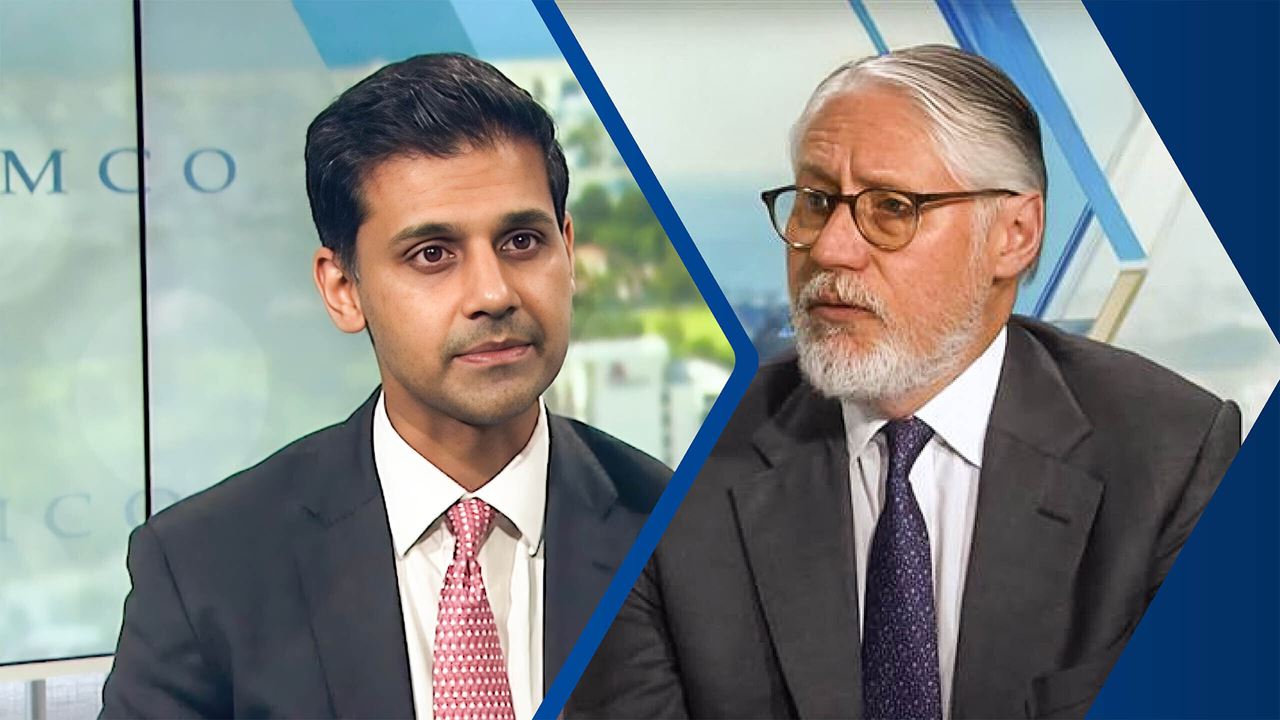Stay tuned after the conclusion of the podcast for additional important information.
GREG HALL: Hey, everybody. Welcome to another edition of Accrued Interest, PIMCO's podcast dedicated to serving financial advisors and their clients. Really timely discussion today with Greg Sharenow. Greg is a managing director in our Newport Beach office. He looks after our commodity investing business, which includes a number of products on the traditional side, on the hedge fund side.
He takes a really expansive global view of his sector, which of course, draws in and draws on a lot of PIMCO's macro expertise and our views about government policy around the world, about the shape of underlying economies, the direction of rates and all the markets that, you know, have influence over what commodities themselves do. It’s timely on a number of fronts.
We're gonna be talking about gold today, which I think if it's not every headline on Bloomberg this morning it's most of them. And we'll be talking about energy and some of the changes to energy demand brought on by AI and some of the difficulties in serving that demand due to energy infrastructure in the US and globally. It's gonna be a little confusing having two Gregs on the podcast. This is a first for us. But anyways Mr. Sharenow, welcome to the pod and thanks for joining us.
GREG SHARENOW: Thanks, Greg. It's really nice to be on with you, I look forward to the conversation.
GREG HALL: Yeah. Great. And then also, as always we have one of our account managers in from the field to help us with today's podcast. Brady Morrison joins us. He's sitting in the studio with Greg in Newport Beach, but when he's not doing that, he covers Montana and Idaho for us. And before we started recording here, we were debating sort of what native insight that gives them to commodity markets being from I guess some farm country, you know, out there in Montana and Idaho.
BRADY MORRISON: That's right. Absolutely. Regions with deep ties to agriculture, livestock, you name it. So excited to be here.
GREG HALL: Probably a few AI billionaires hanging around Idaho these days as well, right? Okay. Good, good, good. Well, anyways you know, Greg, why don't, you know I gave you a little bit of an intro on the way in, but maybe, maybe just to set the stage here, you can you can help our listeners understand kind of where you come from and how you got to PIMCO, what you've done in your career, and then give us a little bit of a sense of what you're overseeing these days at PIMCO.
GREG SHARENOW: Sure. I started off my career as a quantitative research analyst at Goldman Sachs, where I focused on portfolio construction theory.
GREG HALL: Was that as exciting as it sounds,
GREG SHARENOW: If you like, a lot of quiet, thoughtful time. Yeah. But if you're interested in, you know, the dynamic markets of commodities, which ultimately attracted me, like it was a very different environment than being an economist for five years, covering the commodity markets itself. And since 2005, I've been an investor in the commodity markets, whether it be at hedge funds or a merchant fund, as well as being at PIMCO now. So for 14 years. So I've been investing in energy primarily in commodities more broadly for almost 20 years at this point, or actually over 20 years.
GREG HALL: What how do you think markets have evolved kind of since you know, your early days it sounds and when you said quantitative research group back at Goldman how have markets evolved, you know, kind of since that time and what made you, what made, you know, focus on becoming an investor as opposed to somebody observing and maybe, you know, taking a more academic interest in these markets?
GREG SHARENOW: I think where the rubber hits the road was sort of where attracted me to the investing side, where at some point you have to see if your views actually, you know, have information content, and do you have an edge? And it's been a race over the last 20 years to continually evolve and improve that edge because you know, your initial part of the question was like, how are things changed?
Well, at one point you could have real information edge on data and lots of sectors in the commodity markets by being advanced, you know, using satellite imagery first aggregating all the public information in a quantitative way. And those things have become commoditized over time. Like things we would spend multiple headcount people, plus a lot of resources on, you can now get on your Bloomberg terminal for free. Or, you know, for a modest amount of money can get, a have third party provider.
So that's led to an evolution of investing styles become much more, there's much more opportunities for systematic investing and quantitatively driven investing in commodities that we've taken advantage of over the last 14 years since I've been at PIMCO. But certainly over the 20 years of me doing this, it's become, in some respects, more professionalized in the way in which we have to approach it.
And a lot of leveraging off of what PIMCO does in the fixed income markets, and understanding how to capture, you know, risk premiums has been another focus to try to create a new edge, because just being faster at having the information is much harder now. And then the other part that's really changed is that China, as it has grown relative to when I started in the late nineties their share of all the commodity markets have exploded.
But also that means there's a little bit of a black box there. Changes in their purchasing patterns could have short term meaningful implications to how the commodity market's clear. And some of that is hard to predict because of the nature of the command and control partly, you know, not entirely command and control, but a lot of that in the commodity.
And we see that bearing out in the trade wars that we are having now between where, you know, they're not buying soybeans, which is the, if you're not talking about gold on the cover of all the newspapers, it's been soybeans for political reasons. And I think that has added a wrinkle that has created greater challenges and analytics but also opportunities because ultimately the economics of the markets need to clear them.
GREG HALL: How does this fit? I think a lot of listeners and financial advisors will be very familiar with PIMCO's fixed income but maybe less so with what we do in commodities. So maybe just give us a sense of the scope of what we do, and then maybe even more importantly, how it fits into the overall investment process at PIMCO and how well integrated it is within some of the other things that we do.
GREG SHARENOW: Yeah, sure. So we manage about 15 to 16 billion in commodities specific mandates.
And then I also manage our multi-asset inflation product where we invest in a variety of inflation sensitive products, which kind of directly links me to a lot of other businesses, whether it be our tips business, which part of our mutual fund and universe actually invest the collateral in tips. So we're deeply integrated with our treasury and inflation link bond desk as well.
But when you break it down, the benefit of being in a place like PIMCO for me as an investor, in addition to like, frankly helping me see new ways of investing in commodities, I think my career was very much extended by being in a place which really focused on structural opportunities, which many commodity investors inherently don't do, because they're trying to get the next move, right?
And not thinking about like, how would a portfolio work over three or five years, if I understand how the carry is gonna drive a commodity trade? Like that's beyond their investment horizon. So, but the other area where it really is benefits me, and I think I benefit the firm, is that having analysts who cover global and portfolio managers that trade global, you know, credits for example, or equities, is that, you know, if I wanna understand what's going on with the oil distribution system in Mexico, because that's gonna matter to Gulf Coast refined product demand, because we're a big source into Mexico, like, it's nice to be able to talk to the guys who cover that, or China economist.
And also when you're trying to process geopolitics I mean, I need to crowdsource. The reality is that while I can contribute to how PIMCO's thinking about geopolitical risk, whether it be in Israel and Iran, whether it be Russia and Ukraine there's only so many things you can be certain of, and having people to really hash out the ideas is critical for me to understand what's going, what might happen and might be an impulse for commodities.
GREG HALL: Well, maybe we'll jump into it. We referenced it at the outset here. And it's a topic, I know, it's on the minds of a lot of advisors out there kind of giving the headlines and no, it's not soybeans. Let's talk about gold. It's you know, in many ways it's a great embodiment of this you know, sort of the macro reflexivity of the commodity markets.
It's sort of its own animal in that regard. But I mean, just to set the stage, you know, I was looking at price action in gold. You know, read the headlines, but it’s sometimes it's good to just pull up the picture and you know what a tear. I mean, since, since 2020, just going back five years, you know, my interpretation, Greg, and you correct me, but it looked like it had a little run in COVID.
I assume a little bit of flight to quality, flight to safety there. Gave all that up. And then some over the course of 2022 with the Fed hiking. And really since 2024, it's been a rocket ship. and then this year up 60% year to date I pulled up Bitcoin just to check on it up 17% year to date as of today's recording. So making, making the crypto guys look, you know risk averse or lower risk in contrast.
And it's since, you know, mid-August it's gone from parabolic to vertical in terms of its price action. So $4,200 this morning, at least last I looked. And just, you know, just sort of setting us up what you know, for lack of a more interesting question, what's going on, Greg?
GREG SHARENOW: Well, I think it's multiple facets that are driving this. When I think about gold, it's a stool with many legs of support. You had starting really in 2022 post the Russia invasion of Ukraine. And even leading up to it, if with hindsight, if you were able to know what Russian central banks were doing, which was buying gold as well as starving Europe of gas supplies ahead of the invasion, like to try to set up a better advantage system for themselves.
When the western world seized Russian assets, I think that really started a cascading situation where ultra-high net worth individuals, but also central banks and sovereign wealth funds that were either opposed to the western world order as one could think about it.
Or we're certainly in between the two, really started thinking about how do they balance their own security. And I think gold really sort of started playing into the idea there. So you needed diversification benefits as well of gold, but really I think it had to do with being a protective asset for a number of countries. And I think…
GREG HALL: Was this also, I think I've heard you talk about it in the past as a sort of a crystallizing moment for you, but the seizure of dollar denominated assets, right. For not just for governments, for individuals as well.
GREG SHARENOW: Yeah. Your chateau in southern France was no longer a useful asset, or the ship that, or the yacht that you had that was, was sunk or seized. I mean, I think the ability to hide wealth in as in outside of some countries became much more challenging. So I think gold has created a bit of more of a premium for the ultra-net worth, ultra-high net worth individuals.
But also the other thing that happened in 2022 was the global inflation shock left countries that thought they would be relatively insulated, really short inflation risk, or really exposed to inflation risk. I'll be more specific. If you look at the 20, like 2000 to 2008 move where we had higher inflation than 2%, nothing like what we saw this decade, but, you know, we certainly saw inflation moving above to 2.5%, 3% at times.
That model included very strong economic growth. We were pushing on the supply chains for a lot of commodities. We saw inflation increasing, but the emerging market economies saw strength in currencies, saw stronger economic activity, and as a result were somewhat insulated, in this case because it was much more of a supply driven shock. They found themselves with weakening local currencies, no virtuous economic cycle, and had a very big sting from the global inflation spike that happened.
So when they were, when a lot of these countries and investors, real money investors were thinking about and looking at their exposures, they found themselves in a situation where they were much shorter real assets and much more exposed to inflation risk than before. So I think that has led to a change in which they're both thinking about gold and inflation risk in general, and commodities as a result.
So that's another part of the idea that like real assets, whether it be a central bank or investor real money, like became a real need for a portfolio. And then, and the last bit is just pure diversification. You know, it's hard to just say that there is no questioning about the existing world order being sustainable, what the government institutions that we had set up, either multilateral or within countries like the United States that are, are seeing meaningful change, has led to a desire to have some diversification of assets in the mix.
So maybe not just US treasuries or some other safe assets, but looking at, you know, historically millennium old investment opportunities. So I think that's also benefited. So there's many things that have been behind it now locally, it seems extraordinarily, extraordinarily rich. You know, it's way outperformed what real yields, which you think is a powerful anchor for how to think about gold on a local basis.
It's at the highest level in real terms, we've seen, you know, in the last 50 or a hundred years. I think that says a lot about, you know, maybe you could have a 10 or 15% retracement, but it wouldn't change the narrative at all. I think the lot of those buyers would just salivate at that opportunity.
GREG HALL: Yeah, it sounds like what you're saying is, you know, there has been maybe a structural shift in demand for gold from, whether it's central banks or actors who realized over the past decade that the global financial system may not, may not be as safe for them you know, as they had thought it was prior to that, coupled with maybe, maybe more cyclical, maybe more structural, who knows, concern about fiscal policy or the traditionally stable trade relationships between major parts of the world. And so there's this safe haven element that's kicked in maybe a little bit more this year than in previous years. Is that a decent summarization?
GREG SHARENOW: Yeah, I think it's, you know, it's becoming self, you know, fulfilling in part because of the momentum in the market. But I do think that actually that trend had started, and we've seen it in our own client base, you know, well before this year. You know, it started a few years ago and it just sort of like spreading and becoming a little bit more prevalent.
But I think it's becoming a little bit self-fulfilling because we've seen and observed the price moves. I mean, the fact that this decade, gold has bested the S&P, which has a high concentration of the MAG 7, which pretty, pretty high bar. And it had actually has been reasonably diversifying to S&P like, I mean, the correlation is 0.1.
I mean, it's pretty, pretty small. So, I think from that standpoint it garnered a lot of attention. But in terms of the diversification, we see international investors just have a huge exposure to the US equity markets have a huge exposure to US rates. So I think the diversification that they're looking for in gold is notable.
GREG HALL: Yeah. It's you had sent me an email, I don't know, maybe six weeks ago. Because we were talking about having this conversation and I think you asked me what are the two top performing assets this decade? And I went back to you sarcastic. I think I said Bitcoin and Taylor Swift. And when you look at the numbers on gold, it's just like, there's nothing stands up to it.
GREG SHARENOW: Yeah. I mean, if we could have all been long Taylor Swift, I think that would've been a great diversifying investment as well.
GREG HALL: Yes. My daughter would have appreciated that. She probably owns gold.
GREG SHARENOW: She's very smart. She is a chip off the old block.
GREG HALL: Absolutely. That's good. That's a very good point. That's a very good point. Her father being a financial advisor. All right, we shouldn't digress too much into Taylor Swift much as we'd enjoy that.
Brady, you gotta get in on this one. You're, you're probably closer in age to most Swifties than Greg and I are, but are you hearing about gold from the FAs that you speak to? And what's the volume of those questions and how long have you been talking about it at this point?
BRADY MORRISON: I think to your point, you can't turn on Bloomberg or CNBC without seeing a gold headline. So it's absolutely in, you know, in conversations with every advisor and their end clients are also asking these questions. And I think as it relates to commodities, some of the trepidation, right? We've had good volatility in areas like gold, but you've had a really strong performance.
You've had some allocations for a lot of financial advisors that were arguably under allocated to commodities in general in 2022. So you have a lot of investors thinking about you know, investing if not for the first time, then revisiting an allocation to commodities. And they're saying, Hey, you know, maybe am I too late to the trade looking at gold, you know, with the recent performance that you highlighted.
So I think it'd be interesting, Greg, if maybe you wanna highlight, you know, some of the historical volatility of the asset class. That's definitely some cause for trepidation for some advisors considering allocation. But also too kind of, where do we go from here in terms of commodity performance and more generally, if that makes sense.
GREG HALL: Yeah, let's stick with gold because, Brady, I think you're asking the question that I wanted to ask on where do we go from here? Because Greg, you kind of alluded to having a valuation model for gold, or at least some form of guideline. And that's the question I want to ask is if an advisor, you know, sort of came to you and asked, you know, $4,200 is gold, cheaper, expensive? How do you answer that question?
GREG SHARENOW: It's a question I'm very, very cautious and trying to respond to, because kind of like Bitcoin in a way where it's, there's a lot of different frameworks. People are just, you know, talking about the cost of energy to produce the marginal coin, you know, and the computing power that were acquired produces one result.
There's other results that could come out. You know, a lot of where the most bullish sentiment comes from is if you start looking at like, increases in share of investor portfolios and or central bank holdings you know, the amount of dollars that would flow in would be meaningful relative to the size of the overall market. And, you know, as a result could see prices move to levels, you know, 5,006--, I mean, the numbers that you can produce outta that is very lofty.
GREG HALL: So that's extrapolating like if central banks get to 5%, the numbers are huge.
GREG SHARENOW: Yeah. Would it be a lot larger? Because the central banks in the emerging markets are at that level are slightly lower and moving higher, but developed markets are in the, you know, mid to high teens. So if, you know, you start just doing the math, like, oh, emerging market looks like developed market. Like, there's no gold.
Like, the difference also between gold and other commodities is that at the end of the day, almost all the gold we've produced is on the surface of the earth. Like maybe there's some buried in with mummies and tombs, and there's, you know, the teeth that went you know, were buried as well, but like for the most part, or some sunken ships with the great coins out there waiting to be found. Yeah. Which I always love those stories. But at the end of the day.
GREG HALL: By the way, quite an incentive to go look for some sunken chips these days at 4,200 an ounce. Right?
GREG SHARENOW: It's not just sport, it's now profit which is the great, the best combination possible. Looks like college football now. But you know, so when I think about how do you come up with a framework, it's very challenging because again, you're basing it on flows. Like higher prices only create more supply through either someone selling their investment, maybe some increase in scrap.
Supply, you know, if you go to 47th Street in New York City, like there's a lot of people standing on the street right now trying to buy your gold from you. Because of, you know, your holdings of gold, whether it be in jewelry, which was at one point fabrication was a larger share of the cost now it's actually the value of the gold that's, you know, makes it so you could sell it for what you bought it for, if not more.
So I think you're, that's it though. But like new mind and incremental mind supplies is slow to develop and over a very long time, given how hard it is to develop mine and mind supply. So I think that makes it very challenging. That said, ultimately it's not a non-revenue generating asset.
You know, if you can get attractive returns in real yields in the order of 170 to 200 basis points or nominal bonds, you know, could nominal bond portfolio is 6% 7%, which I mean, sounds small relative to the 40%, 50% return you've had in gold this year. But usually those environments make it harder for gold to go up because the opportunity cost goes higher. So our framework usually is like, well, it's a real asset. How well do other real assets return?
Well, that should be less attractive for gold right now. So that's why I'm saying locally we think it's overvalued, but the flows have, have been substantial. The one thing that you said before, though, about vol and gold, I mean, the vol and gold is usually like 12 to 15%, which is not as high as equities.
And certainly single stock equities can be, you know, meaningfully higher than that. And if anything, it's actually, you know, fairly even with this move we've had now, like the realized vol has been, call it 17, 18% very much aligned with equities. So it seems scary because it's and people focus on the higher volume in part because it's a little bit outside of the normal investing focus. But in the grand scheme of things, commodity indices overall or gold are not very different. Like if you look since this before COVID till today, it's roughly all the same. So, but the diversification benefits are compelling.
GREG HALL: One of the things that I would imagine advisors grapple with right now, Brady, you can confirm or not, and Greg, you might have an answer on this, but you know, I think despite, obviously, you know, clearly people are buying gold and bullish gold but the paradoxical situation we find ourselves in where, you know, I you think of gold as store of value and you think of gold as competing with cash or competing with, you know, fixed income instruments, given what you just said, Greg.
And, you know, you've got real good yield available in the bond market, which makes it more expensive to hold something that isn't yielding anything at all. Or you think about it as a safe haven in turbulent times and it's like a safe haven from what everything's working this year.
You know, show me the asset class and we'll get into energy in a second. But, but it's hard for me to parse the fear inherent in rallying gold prices with, you know, equity prices that are, you know, nearing or, you know, at all-time highs and all time high valuations. Credit spreads are as tight as we've seen them. How do you in the halls of PIMCO, how do we, you know, break that down and try to come up with an explanation for how that those things could be happening at the same time?
GREG SHARENOW: Brady, do you wanna go first or would you like me to give a…
BRADY MORRISON: Yeah, absolutely. Go for it. Okay.
GREG SHARENOW: So part of it is like when we think about the global liquidity, right? I think can partly explain where you're seeing both improvement in asset classes across the universe.
So some of that money is gonna be moving, obviously, into equities and extend extending the duration in fixed income and looking to buy interesting opportunities there as well. So I think gold is just part of that beneficiary. So it, you know, that kind of puts it when you start talking about the debasement trade that a lot we're focused on, and it's hard to see for the reasons you just said.
Like, if we're really worried about the fiscal balances in the US like the 10 years, what, 50, 60 basis points below where it was, you know, not that long ago this year. So I, you know, it is harder to see the case for, you know, the debasement idea. But that doesn't change the fact that I, for the reasons I said before, there's just a desire to deploy capital in diversifying assets and real assets. We're seeing it across our business suite. And as a result, you know, without a natural supply response that's meaningful, you know, the gold can perform quite well.
GREG HALL: Yeah. Some dollar rotation, some cash being put to work. If it is cash being put to work, I guess it does raise a little bit of the specter, you know, and sometimes we think about Bitcoin in this regard as well too. It's like, is it a risk off trade or is it a risk on trade?
And some of these correlations in the future, I would imagine may not behave right if it is liquidity, pursuing risk on and chasing a rallying commodity. You know, when times do become more turbulent, when we do encounter economic distress may not see the kind of price performance from these traditional, I shouldn't say traditional with regard to Bitcoin, but certainly with gold you know, the safe haven, you know, destination might see a totally different outcome.
GREG SHARENOW: So when I look at Bitcoin, it's very hard. Is it a real asset? I mean, is it, we don't have enough history. It's much more complicated to answer that question. In gold, we have definitely seen like in 2008, and people will not forget that moment where de-leveraging across all portfolios led to a selloff in gold.
However, extend the horizon just a little bit. And gold responded, it recovered back. And you can say the same in a few other episodes that we had like in 2020 initially, like, we're gold sold off. And then, you know, when it was obvious that there was gonna be a meaningful fiscal stimulus as well as monetary stimulus, gold accelerated. So I think in small windows of time, it's pretty easy to say like, oh, this is not gonna insulate my entire portfolio. I mean, there's no doubt.
I mean, the volatility in every asset class would make that hard to say with any certainty. But when you start looking at the fullness of time, you know, you end up seeing the benefits. So like you could take this decade, for example, commodities broadly, or gold, typically you would expect them to perform really well when inflation's above to, you know, the central bank targets and they're some of the best performing asset classes, and they were diversifying, that didn't mean that they did great from second half of 2022 to mid-2023, there was definitely a period of weakness.
But in many respects, it's consistent with what your textbook expectations would've been prior to it. Where you would have a situation that you would expect real assets to be a meaningful contributor, both to returns but also meaningfully diversifying. And all it took was inflation just being above the targets.
It didn't take, you didn't require just high inflation and uncontrolled inflation, you know, you see the real benefits. So I think while you can't get the day to day right, or month to month, I mean, period, like if, for investors who do think about portfolio construction over extended periods of time, it was very consistent with what one would've hoped real assets would do.
Liquid real assets. You know, if you have office buildings that are like behind you right now looking out the window, I'm not sure. The podcast listeners can't hear it, but I, I'm seeing it right now. Like, that wasn't so protective, but, you know, liquid real assets did perform.
GREG HALL: There's a lot to unpack in there. I think you know, we were obviously want to ask you, you know, your views on inflation protection in a two-legged individual's portfolio, right? Us human beings who are charged with you know, managing money on behalf of our clients, our families, you know, to prepare, you know, for later in life and retirement and all that.
How do you, you raised the topic, so let's go into it. How do you think about using commodities or any other instrument to insulate portfolios against inflation? And what's the framework you would advise advisors, you know, to adopt and communicate to their clients?
GREG SHARENOW: When you were saying two leg, I thought you were talking about like a 60-40 portfolio. I didn't realize you meant almost eight.
GREG HALL: No, no. We use it to differentiate, you know, like the central bank investor with the limitless time horizon or the monetary policy goals from those of us, those walking around you know. Yeah.
GREG SHARENOW: Got you. Yeah. So when I start thinking about what is my risks personally, because it's, I'm a two legged individual not a central bank. And I think about what are my, what is my concern about meeting my retirement goals? Well, one is inflation eating away at my asset base and my spending power, right?
So if I look over the last 50 or a hundred years as like examples for where we look at the benefits of having diversification, it is clear that when inflation is, you know, 2% plus it doesn't even have to be 5%, like just above an optimized portfolio would include a pretty hefty allocation to commodities and or real assets. When I say like, you know, it could be as high as 25%, 30%, you know, in sort of you know, in the mirror when you're looking back that is probably pretty high for most, you know, investors thinking about them.
But I don't think a three to 6% allocation is like in unreasonable. And you can almost argue that as you get to closer to retirement, you may want more simply to protect your purchasing power because you're at time for your assets to recover start shrinking when you need them for meeting your life's goals.
So, I it's always complicated when you're moving further away from your traditional investing of the 60-40 portfolio. But history is repeatedly shown that if inflation is a concern, which is a concern for retirees and savers it's important to have the ability to protect that spending power.
GREG HALL: Brady. Do you think do you think financial advisors, by and large are thinking kind of mid-single digits higher, lower? Where do you think the average advisor falls out on this?
BRADY MORRISON: Yeah. So, for those who are making an allocation to commodities, typically between one to 7%. I haven't seen it too much beyond that six or 7%, right? And then talking to a financial advisor yesterday, he says, Hey, I have a commodities line item because gold is in the news and my clients are asking me, Hey, do I have exposure there? Right? So there is an amount of advisors who have a structural allocation, but again, there is a bit of trepidation based on, you know, we already touched on the volatility.
And also I think, you know, what can be a concern is maybe, you know, an investor or an advisor has a view on gold, on energy, less so likely that they're gonna have a view on corn futures, for example. So, Greg, I know the audience would be really interested in hearing, how do you think about making an allocation? Should they buy a broad basket of commodities? How would you think about that from an overall diversification within a broader portfolio?
GREG SHARENOW: I tend to think that it, you could see a combination of both. If you take our multi-asset inflation index for example, we have a gold sleeve, 10%, commodity sleeve, 20%. And we do think that there's benefits to having both given this late is moving gold.
We think is the best way to approach investing in commodities because we do think that there's a lot of supply side constraints through underinvestment that's emerging a corn, as you mentioned, that specifically is gonna be a functional weather and growing, we've had a couple decent years of good weather conditions.
So corn prices are down, which is great for the global economy, for the global south, who, you know, food is a larger share of their spending requirements than maybe the average American would be.
But in general, when you start looking at metals, and we just, you know, Greg mentioned and teased early on about AI, the thing about investing in the, whether it be industrial, military, industrial complex, whether it be the energy transition or now AI, it's massively commodity intensive. And while one could argue that productivity will increase, and ultimately as we invest in new energy, we'll be able to have lower marginal prices.
The process of getting there is very commodity and energy intensive, whether it be in metals or whether it be the energy requirement to accomplish this. So I do think having a broad commodity investing is actually pretty appropriate for investors to have right now. Now, the one other thing I wanna note real quickly about investing in commodities, it's fully collateralized. So for a hundred dollars investing in commodities, you get a hundred dollars of T-bills in the way in which the indices are calculated now.
PIMCO, that's anathema to not invest that cash. It's something better than T-bills or try to outperform. But my point is that if you're looking at even rates at like three point a half or 4%, you know, commodity investing right now gets that general benefit when the markets, when you're looking at your portfolio. So I think the attractiveness of the space is appealing and again, the diversification benefits are compelling.
GREG HALL: So what do you in the US at least then, and let's switch to the AI transition and, you know, energy markets haven't kept pace with what we've been talking about gold and Bitcoin and some of these, you know, more macro sensitive commodities.
What are you expecting in the years ahead in terms of you know, kind of the effect of AI on your area of investment and where should advisors be kind of looking for things that might have some of that micro strength that you were just referencing?
GREG SHARENOW: So energy broadly has been weighed down by the fact that OPEC in particular, but also some benefits from prior large scale investments that have come to fruition where we're seeing a pretty meaningful oil production cycle right now. That is going to be turning in the next 18 months to two years, in part because the big projects are coming off, there's also a variety of meaningful risks, whether it be reports yesterday about the US potentially taking action within Venezuela, which I have no public comment on because I still don't understand exactly what's happening.
But you also have growing sanction and extraterritorial sanctions being applied by not only the US but potentially Europe on lifters or Russian oil, as well as the snapback of sanctions in Iran. So there are some things that could change the supply scenario, and if that's the case, you know, oil would recover pretty meaningfully here.
But I think that's been the main reason why you've seen oil prices underperform others. And but you know, it could diversified commodity index is still doing great because we have, you know, that diversification natural gas is always a little bit unique in the sense that it's also a very weather sensitive commodity.
The summer was not particularly positive. But if you look at the back end of the power curves, and if you look at retail power prices in part because of the allocation of costs that need to be borne by someone and you can see the political challenges of that right now about who pays for the infrastructure to support the power.
If you live in one state that's connected to the power market in another state that's now seeing meaningful load growth because of AI and data center investments, but you don't get any economic benefits in your state, are we gonna still have well-functioning power markets? I mean, these are real questions that this growth is challenging. So while has--
GREG HALL: So this is, let me, I wanna understand that. So, a state that is AI friendly, that is permitting and allowing people to build massive data centers is drawing power from the grid raising prices for everybody. And the state next to them, you know, maybe for any number of potentially good reasons is not, you know, is not allowed, the hyperscalers to build massive data centers all of a sudden, you know, it's sort of an unequal pros and cons distribution across those two states.
GREG SHARENOW: This is a real political problem evolving. And by the way, the example I was talking about was like, if you look at Virginia, it's in part because some of the earliest and large scale investors was actually the US government, US military, and so forth. So it's not like they were just way more friendly. They just actually just had a load pocket that was early action.
You know, all of a sudden all the neighboring states that are part of a joint operating market for power is like lagging behind in the building of these data centers, but are realizing the tensions in the investments that need to happen to support load growth throughout the whole system. But you're gonna have this as a real challenge because who's gonna bear the costs and costs are obviously after the last inflation cycle, really front and foremost in the political discussions.
So, there's a lot of tension in meeting the future demand. Like, are we gonna build more nuclear plants finally, and if so, how are we gonna do it in a way in which is cost effective and timely? Right? Because if you're trying to build a nuclear plant, other than the restart ones we're looking at, it's still a very extended timeline. So, it's not gonna solve four or five years from now load growth.
So, that's where I think the excitement about power markets or where you're starting, where you've seen some of the way in which AI has come into play. But that's like, again, pricing something further down the future, because we're building it right now, we're not quite using it as much as, as we will be.
GREG HALL: I saw it may have even been in our own forum, but I saw a chart of power usage in the US where, you know, it's this flat, you know, kind of tiny little bumpy line forever, right? And it explained as kind of, you know power usage has been, you know, we all use more electricity in our daily lives and more of us use electricity in our daily lives.
But now I've got LED light bulbs and, you know, and our batteries have become more efficient and every aspect of our lives has become more efficient. And so, you know, even as more of us use more electricity, the power consumption or power generation has stayed, you know, kind of relatively constant.
And then I saw the projection was with AI, you know, with my daughters, you know, making videos of puppies on the beach costing 50,000 times as much as, you know, typical Google search like that number could be jumping 10, 20, 30, 40%. and that, you know, do you see that kind of ramp from here? Or are you a little bit more skeptical of where we could go in terms of power consumption?
GREG SHARENOW: So, part of the power consumption could be simply limiting, what we can do. Like it's a possible, you just have this sheer supply constraint. But I do wanna digress for one second and say we should close any video recording of this with that puppy video on the beach. I think our clients would love that.
But, if you look at the US, there's no doubt that we're going from 25 basis point growth for the last 15 years to something probably north of 1.5%. Now, the one area where I would caution is that we often in markets, commodity markets in particular, when there is a wall we are worried about, we tend to figure out ways to avoid hitting it.
You know, lithium was a prime example where everyone was super excited about electric vehicle demand growth and battery, storage demand growth, and prices went through the roof and then we adjusted our demand and then we, you know, created a new supply.
Similar here is if you're looking at chips, like there's gonna be a big premium for energy efficiency there's also gonna be a lot of management of load that you could do. So, it doesn't mean I'm bearish it, you know, I'm just saying like some of the frothy forecasts may end up being tough to realize. But the tailwinds though, are clearly in the direction of travel, right?
And you're gonna see meaningful additions in power demand. You're gonna see meaningful additions and materials required to build the data centers, to build the chips to build the grid to support it. And it's, that train has left the station and is gathering steam. But again, if you gimme a 10-year horizon and say, is it one and a half, one and a quarter, or is it two and a quarter? Like, it could be any number of those.
But I think the Nvidia CEO is on a Columbia University podcast with Jason Bordoff not that long ago, and he was talking about the efficiency and energy improvement in the chips that they've done. Over time, and it's notable, I mean, it's really remarkable the amount that they've managed to improve it. So again technology is a race. And I think you could see some of the energy efficiency creeping in faster than what a current assumption are.
GREG HALL: It's fascinating stuff. And I think, you know, in this latter part of the conversation, you know, seeing in some of these other commodity markets, energy power you know, a little bit, you know, some of the same macro qualities as gold in terms of inflation hedging and that sort of diversifying role in the portfolio.
Maybe what I'm hearing from you, Greg, is the stronger micro case for, you know, price action and in those commodities relative to gold. Not that you made a prediction about one or the other outperforming, but at least some more intrinsic fundamental, you know, drivers of usage coming up in some of those areas.
I think this is all great. I think we've laid a great groundwork here for future podcasts, where we can revisit this conversation and talk about these issues. I don't think they're gonna be leaving us anytime soon. Greg, thanks for all the time this morning. Really appreciate you joining us. Like I mentioned, we'll do this again. You've earned your way back. And we'll revisit these topics and themes. Brady, thanks for coming in from Wyoming, Montana, or Idaho wherever you last were.
And you know, just as a reminder to all of you listening accrued interest as part of our advisor Forum platform, advisor forum is your destination at PIMCO for all things designed to help you serve your clients to do so pragmatically, efficiently and give them the best advice that you can give them. If you visit us @pimco.com and identify yourself as a financial advisor, you'll be taken straight to Advisor Forum, where we've curated a selection of thought leadership and tools that you can use on behalf of your clients to make better decisions.
If you enjoyed today's podcast, if you enjoyed previous podcasts, feel free to like and subscribe. Knowing how many of you're out there helps us tailor our programming and do a better job serving you. Until next time, thanks so much, and we'll talk to you soon.
From This Episode
- Commodity Markets’ Evolution: Efficiency is Table Stakes
- Why Gold is a Rocket Ship Recently
- Debasement Trade or Diversifying Asset? Making Sense of Investor Sentiment with Gold.
- Protecting Spending Power with Commodities
- AI is Booming. Will Energy Markets Keep Up with Growing Demand?
- Benefits of Active Management in Commodities Investing
Check out Charting Commodity Markets
Follow Greg Sharenow on LinkedIn, for PIMCO’s latest views on commodities and real assets


